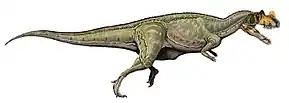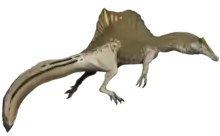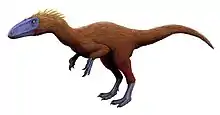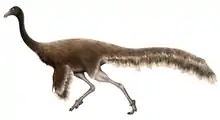Lourinhanosaurus
Lourinhanosaurus (meaning "Lourinhã lizard") was a genus of carnivorous theropod dinosaur that lived during the Late Jurassic Period (Kimmeridgian/Tithonian) in Portugal. It is one of many large predators discovered at the Lourinhã Formation and probably competed with coeval Torvosaurus gurneyi, Allosaurus europaeus, and Ceratosaurus.[1]
| Lourinhanosaurus | |
|---|---|
 | |
| Reconstructed skeleton, Museum of Lourinhã | |
| Scientific classification | |
| Kingdom: | Animalia |
| Phylum: | Chordata |
| Clade: | Dinosauria |
| Clade: | Saurischia |
| Clade: | Theropoda |
| Genus: | †Lourinhanosaurus Mateus, 1998 |
| Species: | †L. antunesi |
| Binomial name | |
| †Lourinhanosaurus antunesi Mateus, 1998 | |
Discovery and Naming

Its first remains were found at Peralta, near Lourinhã, Portugal in 1982, but were not described until 1998, by Portuguese paleontologist Octávio Mateus.[2] Its type (and to date only) species is L. antunesi, in honour of Portuguese paleontologist Miguel Telles Antunes.
To date, the most complete specimen of L. antunesi found is a partial skeleton. The holotype, ML 370, consists of the remains of six cervical vertebrae with six ribs, five sacral vertebrae with ribs, 14 caudal vertebrae, eight chevrons, both femora, right tibia and fibula, one metatarsus, two ilia and both pubes and ischia, as well as an associated 32 gastroliths. A femur (ML 555) found at Porto das Barcas (Lourinhã Formation; Late Jurassic) has also been referred to L. antunesi.
Besides these specimens, around 100 eggs (specimen number ML 565), some of them containing embryonic bones, have been found in 1993 at the nearby beach of Paimogo.[3] These were in 2001 assigned to L. antunesi.[4]
Both the skeleton and the eggs are on display at Museu da Lourinhã.
Paleobiology

L. antunesi was rather large. The individual found was a sub-adult, measuring some 4.5 m in length and weighing around 160 kg. Histology shows that the holotype specimen was between 14 and 17 years old.[5]
Though gastroliths have been found in other theropods since the description of L. antunesi, this was the first theropod dinosaur for which this kind of remains have been assigned. It was concluded during the description that these stones belonged to the animal, and were not swallowed while eating an herbivorous dinosaur.
Dinosaur eggs and embryos, believed to be those of Lourinhanosaurus, have also been discovered; a nest containing more than 100 eggs, some with well-preserved embryos, was announced in 1998.[6][7]
Classification
The relationships of Lourinhanosaurus to other theropods have been uncertain, and no firm consensus has been reached as to its classification. Initially regarded as a primitive member of Allosauroidea, it was later discussed as being closely related to Sinraptoridae, a more inclusive clade within Allosauroidea. Recently, some researchers have been favourable to the idea that L. antunesi is not even an allosauroid, but in fact a member of Megalosauroidea, a more primitive group of tetanuran theropods. Benson et al. (2010) found it and Poekilopleuron to belong to Sinraptoridae.[8] Carrano et al. (2012) found it to be a coelurosaur.[9]
References
- Hendrickx, Christophe; Mateus, Octávio (2014). "Torvosaurus gurneyi n. sp., the Largest Terrestrial Predator from Europe, and a Proposed Terminology of the Maxilla Anatomy in Nonavian Theropods". PLoS ONE. 9 (3): e88905. Bibcode:2014PLoSO...988905H. doi:10.1371/journal.pone.0088905. PMC 3943790. PMID 24598585.
- Mateus, O (1998). "Lourinhanosaurus antunesi, a new Upper Jurassic allosauroid (Dinosauria: Theropoda) from Lourinhã (Portugal)". Memórias da Academia de Ciências de Lisboa. 37: 111–24.
- Mateus, I; Mateus, H; Antunes, MT; Mateus, O; Taquet, P; Ribeiro, V; Manuppella, G (1998). "Upper Jurassic theropod dinosaur embryos from Lourinhã (Portugal)". Memórias da Academia das Ciências de Lisboa. 37: 101–10.
- Mateus, O; Antunes, M.T.; Taquet, P. (2001). "Dinosaur ontogeny : the case of Lourinhanosaurus (Late Jurassic, Portugal)". Journal of Vertebrate Paleontology. 21 (supplement to 3): 78A.
- Waskow, Katja; Mateus, Octavio (2017). "Dorsal rib histology of dinosaurs and a crocodylomorph from western Portugal: Skeletochronological implications on age determination and life history traits". Comptes Rendus Palevol. 16: 425–439. doi:10.1016/j.crpv.2017.01.003.
- Antunes M.T.; Taquet P.; Ribeiro V. (1998). "Upper Jurassic dinosaur and crocodile eggs from Paimogo nesting site (Lourinhã- Portugal)". Memórias da Academia de Ciências de Lisboa. 37: 83–100.
- Mateus, O., Walen, A., and Antunes, M.T. (2006). "The Large Theropod Fauna of the Lourinha Formation (Portugal) and its Similarity to the Morrison Formation, With a Description of a New Species of Allosaurus" Archived 2012-04-20 at the Wayback Machine in: Foster, J.R. and Lucas, S. G. R.M., eds., Paleontology and Geology of the Upper Jurassic Morrison Formation. New Mexico Museum of Natural History and Science Bulletin 36.
- Benson, Roger B. J.; Carrano, Matthew T.; Brusatte, Stephen L. (2009). "A new clade of archaic large-bodied predatory dinosaurs (Theropoda: Allosauroidea) that survived to the latest Mesozoic". Naturwissenschaften. 97 (1): 71–8. Bibcode:2010NW.....97...71B. doi:10.1007/s00114-009-0614-x. PMID 19826771. Supporting Information
- Carrano, Matthew T.; Benson, Roger B. J.; Sampson, Scott D. (2012). "The phylogeny of Tetanurae (Dinosauria: Theropoda)". Journal of Systematic Palaeontology. 10 (2): 211. doi:10.1080/14772019.2011.630927.
- De Ricqlès, Armand; Mateus, Octávio; Antunes, Miguel Telles; Taquet, Philippe (2001). "Histomorphogenesis of embryos of Upper Jurassic Theropods from Lourinhã (Portugal)". Comptes Rendus de l'Académie des Sciences, Série IIA. 332 (10): 647. Bibcode:2001CRASE.332..647D. doi:10.1016/S1251-8050(01)01580-4.
- Antunes, Miguel Telles; Mateus, Octávio (2003). "Dinosaurs of Portugal". Comptes Rendus Palevol. 2: 77. doi:10.1016/S1631-0683(03)00003-4.













